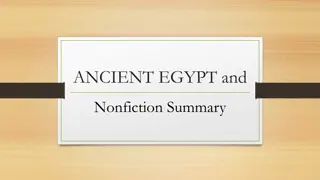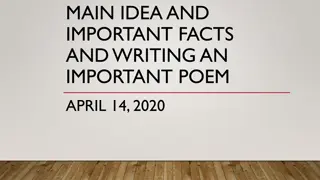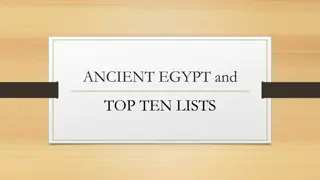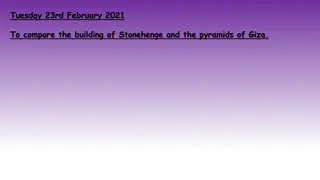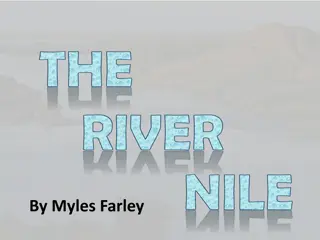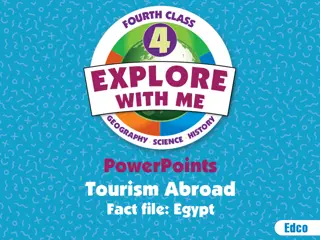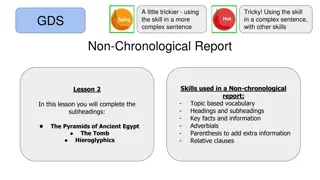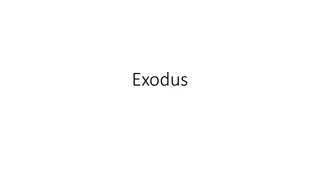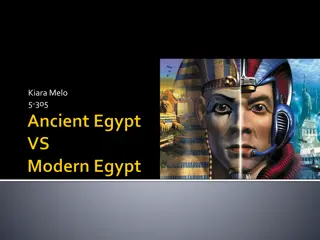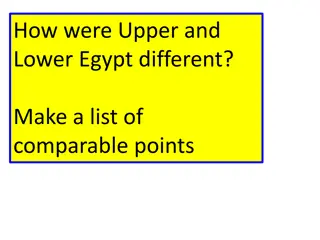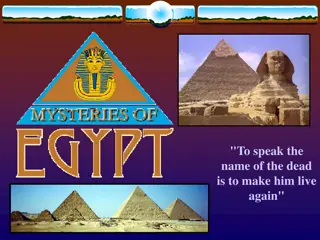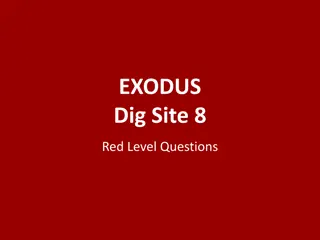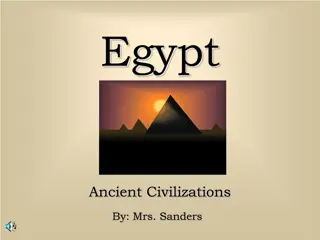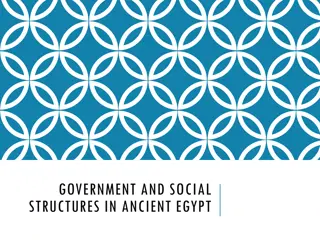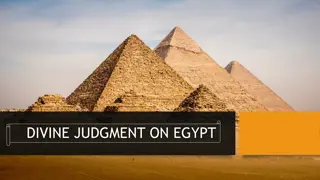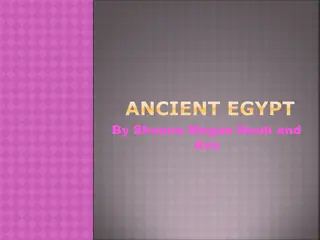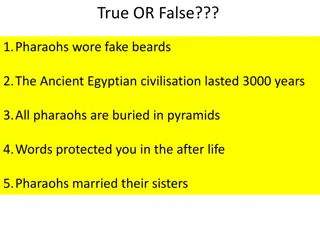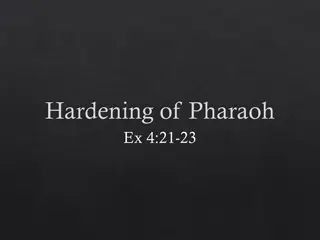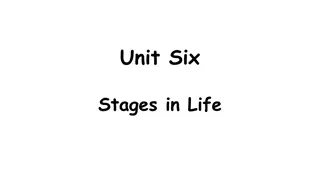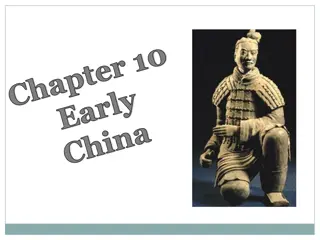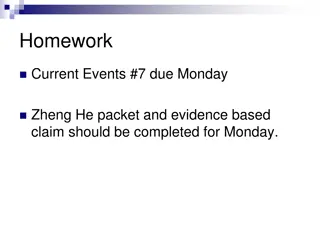Unveiling the Mysteries of Tutankhamun: A Journey into Ancient Egypt's Pharaoh Dynasty
Delve into the enigmatic life and death of Tutankhamun, the last ruler of the powerful Pharaoh Dynasty in ancient Egypt. Uncover the intrigue surrounding his tomb, the curse that shrouded his legacy, and the beliefs in life after death that guided the pharaohs' burials. Explore the vocabulary, imagery, and rituals that shape our understanding of this captivating era.
Download Presentation

Please find below an Image/Link to download the presentation.
The content on the website is provided AS IS for your information and personal use only. It may not be sold, licensed, or shared on other websites without obtaining consent from the author. Download presentation by click this link. If you encounter any issues during the download, it is possible that the publisher has removed the file from their server.
E N D
Presentation Transcript
Discovering Tut: The Saga Continues BY A R WILLIAMS
Introduction Written by A.R. Williams, this chapter is about the last heir of the powerful Pharaoh Dynasty, Tutankhamun, who died when he was a teenager after ruling for nine years. He died in a mysterious way, this chapter throws light over all the possible mysteries the curse, where his tomb lies, his life and ultimately death. Egyptians believe that there is life after death and that is the reason why the Pharaohs were buried with wealth and the items used everyday.
Vocabulary Heir Inheritor, successor Laden loaded Speculated- form a theory without evidence Tomb- an enclosure to bury the dead Forensic Reconstruction the process of recreating the face of an individual Pharaoh- a ruler in ancien
Stirred move or cause to move slightly Ghostly eerie and unnatural; unreal Resting place- here, the grave Cemetery- a large burial ground Dark-bellied dark in colour Scudded across moving quickly; it refers to the movement of the dark-bellied clouds Veiling to cover something Casket- a small ornamental box or chest for holding jewels, letters, or other valued objects. Casket grey It means that the grey clouds were like a grey coloured casket which contained the stars. The stars are like jewels which are kept in a casket. Glided quite, continuous motion Probe to investigate, find out Lingering long-lasting
Descended moved or gathered Cramped very small to fit into Rock-cut - made in a rock by cutting it Gazed to look in surprise or in admiration Murals a painting or other artwork executed directly on the wall Gilded covered with a thin sheet or coating of gold Striking- prominent Whisper- to speak in a low voice Pondering think about something carefully
Futile pointless; incapable of producing the result of something Ransacked raid; go through a place to steal or damage something Antiquity age, oldness Resurrection restoration to life Afterlife- life after death, based on the belief that the essential part of an individual's identity continues to the next life after the death of the physical body Funerary Treasures the valuable things with which the king was buried Shroud a length of cloth in which a dead person is wrapped Adorned decorated Garlands of willow a wreath of flowers and leaves Resins a sticky flammable substance that is insoluble in water Legitimate - reasonable
Blazing very hot Budged moved or shifted; a slight movement Chiselled away to cut something with a chisel Circumvented find a way around; thieves would have found a way to tackle the guards and remove the gold from the tomb Inlaid - a decorative pattern on a surface Amulet - an ornament or small piece of jewellery thought to give protection against evil, danger, or disease. Sheaths a close-fitting cover Adornments ornaments Concealed- hid
Intervening occur in the time between events Intriguing to arouse one s curiosity Startling unexpected or surprising Computed Tomography Also called a CT scan, it is a three-dimensional scan of a body with the help of hundreds of X-Rays in cross-section together Wacky amusing in a slightly odd way Eerie detail strange image of Tut s head as visible with the help of CT scan Forensics the application of the scientific method to investigate a crime Anatomy the branch of science which deals with the bodily structure of humans, animals or other living beings Burial burying the dead Shrine holy place
Pallbearers a person who helps to escort a coffin at a funeral Swirling to spin or twist Hydraulic lift a lift that uses a machine to lift or move heavy objects with a pressure Sprinted ran at a high speed stood Orion the constellation that the ancient Egyptians knew as the soul of Osiris, the god of the afterlife watching over the boy king. Astonishing amazing Pixels - a pixel is a single point in a graphic image Spun to turn around Vertebrae series of small bones which form a backbone
Explanation Tutankhamun was the last leader of the great Pharaoh Dynasty. He was young when he died. According to some people, his death was a murder. In the year 1922, his tomb was exposed by Howard Carter, an Archaeologist. After 80 years, he was taken for the CT scan to solve the mystery of his life and death through a forensic reconstruction. His father or grandfather, Amenhotep III, was a very powerful Pharaoh ruler over a period of 40 years. Moreover, his son, Amenhotep IV, succeeded him and initiated the strangest period in the history of Egypt. His name changed to Akhenaten which means servant of Athens. He changed the religious capital from Thebes to Amarna. Later he attacked Amun, a god, ruined his images and shut his temples. Another mysterious ruler thrived him who died very soon. Tutankhamun sat on the power and ruled for 9 years.
When Tuts mummified body was found, he had lots of gold and wealth. Carter got him after so many years. After conducting the research on the treasures, he planned to examine his 3 nested boxes. Many parts of the treasure in the tomb were already misplaced. His tomb was found rock-cut, 26 feet under the ground, which also had some wall paintings. It reveals that he was suppressed in the months of March or April. One of the coffin put Carter into trouble. The gums used to paste Tut to the lowest of the solid gold. Coffin was toughening enough that made it impossible to displace. He put the box in the sun for numerous hours so that the resins lose up but that didn t work. At last, he removed the adhesive with the chisel and hammer. Carter sensed he didn t have any other choice than cutting the mummy from limb to limb, thieves would have robbed the gold and the treasures. His men first removed the head of the mummy, then they cut off each and every joint. After the process of removing all the body parts, they placed it on the layer of sand. They kept the parts in a wooden box and placed it at the original place.
Later, in January 2009, the body was taken for a CT scan which takes hundreds of X-Rays and generates a 3D image. That night after the scan, the workmen passed his body from the tomb into a box. They went through the ramp and stairs and lifted the body on a hydraulic trailer that was holding the scanner. The scanner suddenly stopped working and the process of the CT scan stopped. After the use of a pair of spare fans, the scan was finally completed. After 3 hours, they transferred his body back to his tomb where his body is now resting in peace.
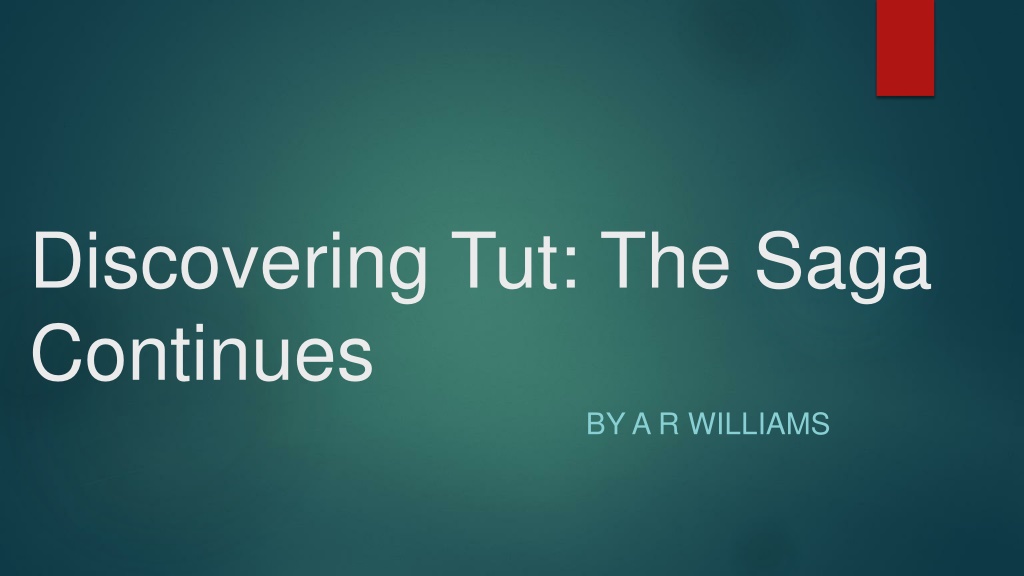

![[PDF⚡READ❤ONLINE] Tutankhamun's Trumpet: Ancient Egypt in 100 Objects from the](/thumb/20549/pdf-read-online-tutankhamun-s-trumpet-ancient-egypt-in-100-objects-from-the.jpg)
